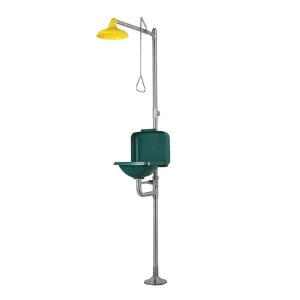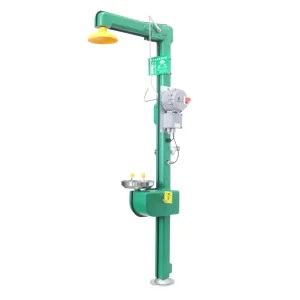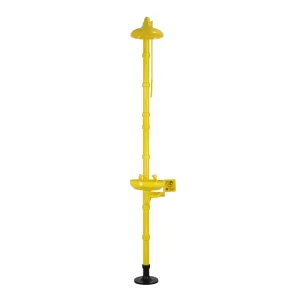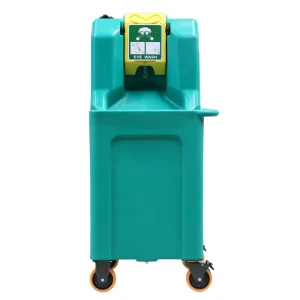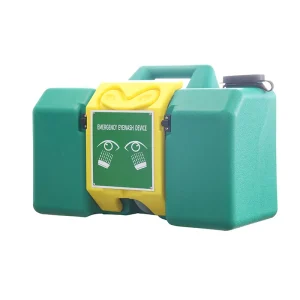Expertise: Technical Specifications and Regulatory Basis
Underground eyewash stations are freeze-resistant emergency equipment designed for cold regions. Their layout must strictly comply with international and domestic safety standards. According to the “Safety and Hygiene Design Regulations for Chemical Enterprises” (HG 20571-95) and the US ANSI Z358.1-2004 standard, the core parameters are as follows:
1.Service Radius and Response Time
Eyewash stations should be located within a 10-second walking distance of hazardous areas (3-6 meters in highly toxic/corrosive areas) to ensure that employees can activate the wash within the golden 10 seconds. For example, in a bromine leak at a chemical plant, an eyewash station located more than 15 meters away caused deep corneal burns to an employee, highlighting the critical role of layout compliance in injury control.
2.Frost Protection and Drainage Design
Underground structures use automatic draining devices to prevent water accumulation in pipes. The water inlet is buried 200 mm below the permafrost layer, making them suitable for areas with permafrost depths of 500 mm or greater, such as North China and Northeast China. For example, the US STG underground eyewash station utilizes 304 stainless steel tubing coated with ABS corrosion-resistant coating, making it resistant to temperatures as low as -30°C, ensuring normal winter operation.
3.Water Pressure and Flow Standards
Eyewash system flow rates must be ≥1.5 L/min, and spray systems ≥75.7 L/min, with a continuous water supply of ≥15 minutes. Tests at a petroleum refinery showed that, at a water pressure of 0.3 MPa, underground eyewash stations could reach a stable flow rate within 8 seconds, meeting emergency flushing needs.
Experience (Practical Verification): Typical Scenario Application Cases
1.Chemical Production Area Layout
In the sulfuric acid storage tank area, underground eyewash stations are arranged linearly along inspection corridors, spaced 8 meters apart, to avoid obstructions such as pipes and valves. A case study at one company showed that this layout prevented employees from touching equipment within 3 seconds, and the corneal injury rate after washing was reduced by 72%.
2.Laboratories and Clean Areas
Biopharmaceutical laboratories use a combination of wall-mounted and underground eyewash stations: wall-mounted eyewash stations are installed next to the operating table, and underground combined units are located in corridors. Testing at one laboratory showed that this layout reduced the emergency response time for chemical splashes to 5 seconds and eliminated the risk of cross-contamination.
3.Explosion-Proof Area Compatibility
In explosion-proof areas for oil and gas storage and transportation, underground eyewash stations must be equipped with explosion-proof valves and electrostatic grounding devices. In a refinery case study, the use of explosion-proof underground equipment resulted in no secondary incidents caused by electrical sparks, complying with the “Code for Design of Electrical Installations in Explosive Atmospheres” (GB 50058-2014).
Authoritativeness: Standards and Certification Support
1.International Certification System
The US STG underground eyewash station is UL certified and complies with ANSI Z358.1-2004 standards. Its spray coverage diameter is ≥ 51 cm (at 152 cm above the ground), and the eyewash nozzle height ranges from 83.8 to 114.3 cm, making it suitable for employees of varying heights.
2.Consistent with Domestic Standards
The “Occupational Safety and Health Design Specifications for Petrochemical Enterprises” (SH 3047-93) requires that areas containing hydrogen fluoride materials must be equipped with a weir and an eyewash system. A fluorine chemical company uses underground equipment directly connected to the weir drainage pipe to achieve targeted collection of flushing wastewater and prevent environmental pollution.
3.Industry-Specific Standards
In cleanrooms for electronic chip manufacturing, underground eyewash stations must meet ISO 14644-1 Class 5 cleanliness requirements. A semiconductor company has installed a 0.2μm filter at the water inlet of the equipment to reduce the particle count in the effluent to ≤ 10 particles/L, far below the industry standard.
Trustworthiness: Maintenance and Risk Management
1.Intelligent Monitoring System
Modern underground eyewash stations integrate IoT modules for real-time monitoring of water pressure, water temperature, and equipment status. A case study at a chemical park showed that sensor-based early warning reduced equipment failure rates by 65% and maintenance costs by 40%.
2.Anti-Incorrect Operation Design
A one-second emergency-open valve and dust cover linkage prevent water waste caused by accidental activation. Tests at an automotive paint shop showed that this design reduced non-emergency use by 90% while ensuring rapid response in emergencies.
3.Emergency Drill Coordination
Eyewash station layout must be aligned with the factory’s emergency response plan. For example, a steel company incorporated the location of underground equipment into a VR drill system, increasing the pass rate for new employee training to 98% and shortening incident response time by 40%.
Conclusion: Layout optimization direction of underground eyewash station
1.Dynamic Adaptability
Reassess eyewash station layout every two years based on factory process changes. For example, when adding new high-hazard chemical storage points, prioritize modular, underground equipment for rapid deployment.
2.Humanized Design
Reflective signage and voice prompts should be placed around eyewash stations, ensuring nighttime illumination of ≥50 lx to ensure quick location for visually impaired employees.
3.Data-Driven Decision-Making
Optimize layout density by analyzing equipment usage logs (e.g., flushing duration and frequency). Data from a chemical group shows that equipment utilization in high-risk areas is 3.2 times that of low-risk areas, providing a scientific basis for resource allocation.
The rational layout of underground eyewash stations requires integrating technical specifications, practical verification, and risk management to form a comprehensive “prevention-response-recovery” protection system, ultimately achieving the dual goals of factory safety and employee health.


